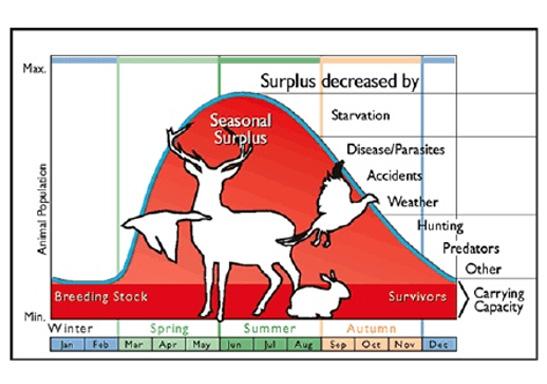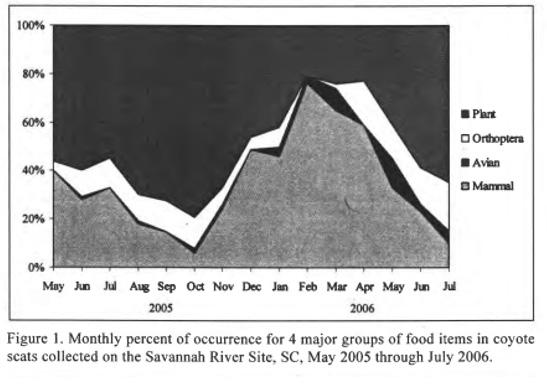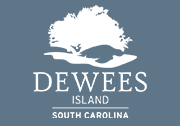Coyotes
Coyotes are not native to South Carolina; it is believed coyotes came here 38 years ago by one of two ways; 1) coyotes migrated to SC from the central US where they are native and 2) they were introduced into SC for illegal hound running. The decimation of Red Wolves from South Carolina provided an opportunity for coyotes to move in.
We are currently managing coyotes on Dewees the same way we manage other wildlife: providing necessary habitat through wise development and managing individuals on a case by case basis. Our strategy is to allow the coyote to fulfill a niche once occupied by red wolves on Dewees Island.
A stable & balanced family group of coyotes comprises fewer individuals than several segregated groups in an area. Research has shown that trapping or shooting the animals may actually increase the number of coyotes in an area due to the disrupted social structure of the family group and it is almost impossible to eliminate them since they will move in from nearby areas.
Summer interns have assisted us with understanding the effects of coyotes. Wildlife camera surveys, scat analysis, population surveys of nesting sea turtles & nesting shorebirds, and vegetation browse surveys by herbaceous animals will all be monitored to ensure coyotes are not causing negative biological effects to the ecology of the island.
If you encounter a coyote, stand your ground. Wave your arms over your head and yell to scare the coyote away. Do not run. Just as with alligators, we want our coyotes to be fearful of humans.
Coyote FAQs
What is the POA's plan to manage coyotes on Dewees Island?
Coyotes on Dewees Island will be managed as all wildlife are: to provide necessary habitat through wise development and manage individuals on a case by case basis. Wildlife camera surveys, scat analysis, population surveys of nesting sea turtles & nesting shorebirds and vegetation browse surveys by herbaceous animals will all be monitored to ensure coyotes are not causing negative biological effects to the ecology of the island. Research has shown that trapping or shooting the animals may actually increase the number of coyotes in an area due to the disrupted social structure of the family group and it is almost impossible to eliminate them since they will move in from nearby areas. The POA has decided to allow the coyote to fulfill a niche once occupied by red wolves on Dewees Island. A stable & balanced family group of coyotes is comprised of fewer individuals than several segregated groups in an area.
I heard coyotes howling and it sounds like we have a lot more than 3 animals.
Coyotes communicate with others in their family group by barks, howls or yips to stay in touch with each other. They will also vocalize to announce the boundaries of their territory to other coyotes. Coyotes can modulate the frequency and pitch of their vocalizations which often makes their group sound larger than it is.
What should I do if I encounter a coyote?
Coyotes want to avoid you as much as you want to avoid them. If you see a coyote it is most likely a chance encounter. Coyotes are curious and may stop to observe, this is not a sign of aggression. If a coyote comes into your yard or other community spaces please practice coyote hazing. Hazing utilizes deterrents to move an animal out of an area or to discourage an undesirable behavior. Use a variety of hazing methods so coyotes don’t get used to one stimulus. Hazing helps to maintain a coyote’s fear of humans; methods include:
- Stand tall, wave arms and yell at the coyote, approach if necessary until they run away.
- Using noise makers: blow whistle, banging pots and pans together, shake a can filled with pennies.
- Throwing projectiles, sticks or balls toward the animal but not hitting the animal.
- Spray the coyote with a garden hose or water gun filled with vinegar and water.
The coyote may run away, but then stop after a short distance and look at you. It is important to continue to haze until the animal has completely left the area. Do not haze a coyote if is cornered or you feel pups are around or if you have a pet with you; slowly back away.
Please take time to review what to do if you come across a coyote and understand the difference between hazing and harassing. For more information, please click here
Current Coyote Sightings
Please pass along descriptions of all coyote sightings. All of your information is extremely helpful and helps us to understand coyote behavior on Dewees Island and make informed management decisions! If you have a sighting please click here to submit the details. Take note of location, number of coyotes, behaviors, time of day, and other factors (did you have a pet with you? Did you try to haze the coyote?) Please be on the lookout for melanistic (black) individuals.
You may also click here to map your sightings; mapping is important because it gives us a visual of how coyotes are moving around the island over time.
Should I be concerned about my dog?
Coyotes are opportunistic feeders and therefore will take advantage of available food sources. If you have a small dog then it would be in your best interest to keep it on a leash while on Dewees Island, even on the beach. Just as we are mindful of alligators and venomous snakes on Dewees Island as they relate to pets, good judgment should also be practiced for coyotes.
Anything else I should know about coyotes?
Feed pets indoors just as you would to deter rats and raccoons from your home.
If you have a bird feeder control small mammals from feeding in and around bird feeders.
Where did Coyotes come from?
Coyotes are not native to South Carolina; it is believed coyotes came here 38 years ago by one of two ways; 1) coyotes migrated to SC from the central US where they are native and 2) they were introduced into SC for illegal hound running. The decimation of Red Wolves from South Carolina provided an opportunity for coyotes to move in.
What do Coyotes eat?
Coyotes are an opportunistic predator species and they will eat a variety of food. Scat samples collected in several South Carolina research studies revealed the diet of a coyote changes based on seasonal availability. Coastal coyotes also scavenge for food at the high tide line. A research study at Tom Yawkey Wildlife Center, SC and Alligator River, NC in 2009-2011 compared scat samples of coyotes and red wolves. The study revealed the most common food groups of coyotes included small rodents, insects, birds and vegetation/fruit; this represents about 73% of a coastal coyote’s diet. The chart compares the diet of coyotes vs. red wolves during the study period. Based on the diet analysis, coyotes on Dewees Island should help to control the rodent population.
Will coyotes eat all the rabbits, raccoons, fawns, sea turtle eggs and nesting shorebirds?
Dewees Island is unique since we are an island and coyotes are a recent immigrant to the island. We can't say for certain what will happen but we can make an educated guess of what we can expect based on scientific research at other locations. We are actively monitoring on Dewees.
The definition of carrying capacity is the maximum population that an area will support without undergoing deterioration. A small coyote family group may find the available resources necessary on Dewees Island to sustain themselves long-term or they may be here for a short time and then move on. As many of you have witnessed, the population of raccoons on Dewees Island fluctuates over the years; the coyote population will encounter a similar fluctuation as food availability changes.

Coyotes & Sea Turtles: Coyotes are opportunistic feeders. Since 2017 we have observed Sea Turtle nest predation occurring on the first night the nest is laid. We have not observed coyote predation on sea turtle nests after the first night on insitu nests or relocated nests.
Coyotes & Mammals: Studies looking at the relationships between coyotes and other medium sized predators like domestic cats, foxes, skunks and raccoons have shown that coyotes have little impact on medium sized predators outside of foxes and domestic cats in urban areas. We do not allow outdoor cats and we have very seldom seen foxes on the island. When we did have foxes, they predated turtle nests at about the same rate as coyotes.
For more information on coyote relationships with other medium sized predators please click here and here.
As of 2020, current conditions on Dewees Island indicate a healthy deer and raccoon population indicated by trail camera images, plants over browsed by deer are starting to return, shorebirds such as Wilson’s Plovers are successfully nesting, and storms/tides are impacting sea turtle nests to a greater degree than mammals.
How many coyotes will we have on Dewees Island?
The size of the family group will depend on the availability of food and the size of the habitat. A family will consist of an alpha pair which breeds and several other non-breeding family members. This family group will defend their territory from other coyotes. This will help to keep the overall number of coyotes consistent.
I heard coyotes are detrimental to deer populations, is this true?
As noted above, coyotes are opportunistic predator species meaning they will take advantage of a meal when it is available even vegetation, insects and carrion. A study conducted at the Savannah River site in GA analyzed coyote scat from 2005-2006. They found deer fawns were an important part of their diet during fawning but plant matter was also important during this time. Based on diet analysis, coyotes will harvest deer on Dewees Island but it does not appear they will deplete the deer population.


Is a coyote important to the ecology of an area?
Top predators in a habitat are necessary to prevent over grazing of native vegetation by herbaceous animals. Though a coyote is not an exact match to the red wolf as far as diet there is some feeding overlap and coyotes may help to fill a nitch that has been empty for some time.
Additional Resources
The Urban Coyote Research Program has a wealth of information on coyotes including details on animals they have monitored through their tracking program as well as community education materials. To visit please click here
References:
http://www.ncurproceedings.org/ojs/index.php/NCUR2012/article/viewFile/142/88
http://citeseerx.ist.psu.edu/viewdoc/download
https://bioweb.uwlax.edu/bio203/s2009/schmitz_tara/Social%20Structure.htm
http://atlantacoyoteproject.org/coyote-management-co-existence/





